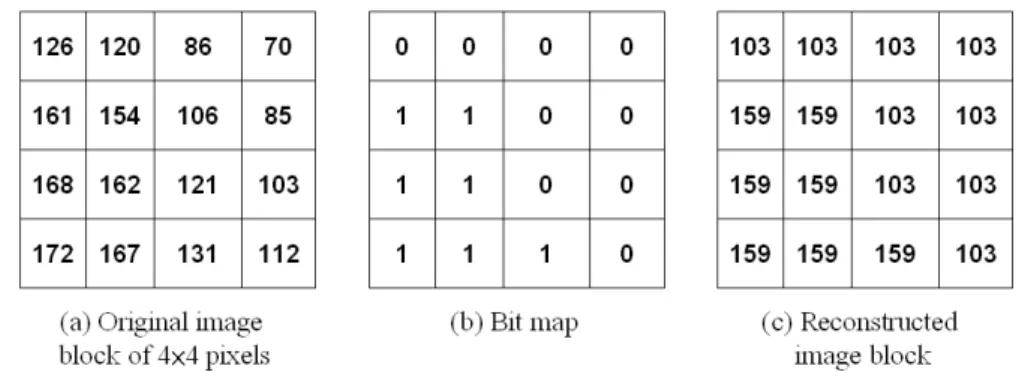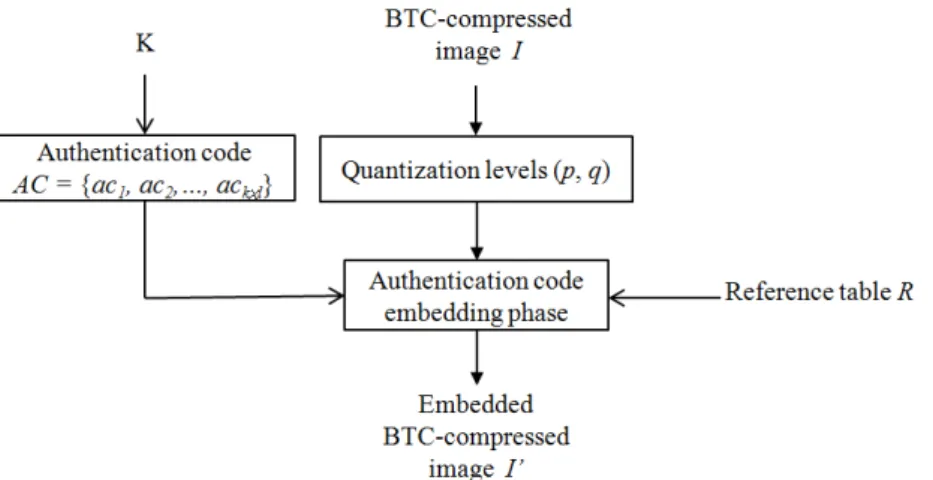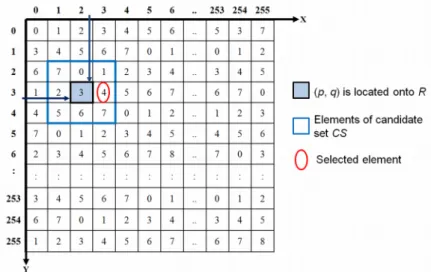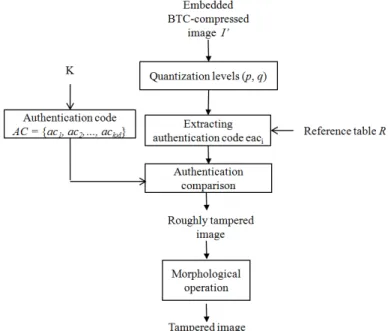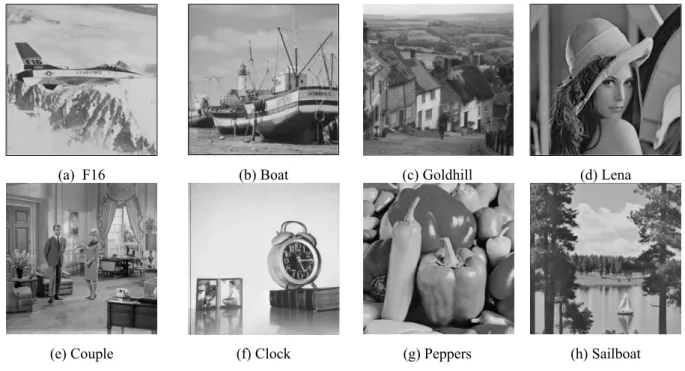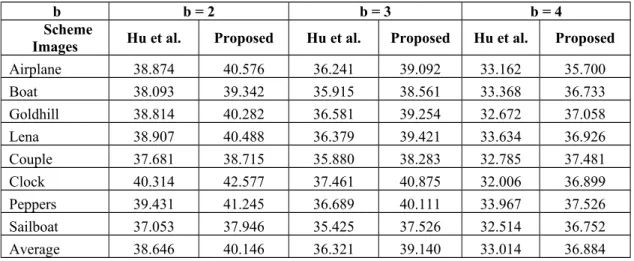A Tamper-Detection Scheme for BTC- Compressed Images with High-Quality
Images
Thai-Son Nguyen1, 2, Chin-Chen Chang1, 3 and Ting-Feng Chung1
1 Department of Information Engineering and Computer Science, Feng Chia University, Taichung 40724, Taiwan, R.O.C,
[e-mail: carter629629@gmail.com]
2Department of Information Technology, Tra Vinh University Tra Vinh Province, Vietnam
[e-mail: thaison@tvu.edu.vn]
3 Department of Biomedical Imaging and Radiological Science, China Medical University Taichung 40402, Taiwan, R.O.C
[e-mail: alan3c@gmail.com]
*Corresponding author: Chin-Chen Chang
Received October 5, 201X; revised November 10, 201X; accepted November 20, 201X;
published December 25, 201X
Abstract
This paper proposes a novel image authentication scheme, aiming at tamper detection for block truncation coding (BTC) compressed image. The authentication code is generated by using the random number generator with a seed, and the size of the authentication code is based on the user’s requirement, with each BTC-compressed image block being used to carry the authentication code using the data hiding method. In the proposed scheme, to obtain a high-quality embedded image, a reference table is used when the authentication code is embedded. The experimental results demonstrated that the proposed scheme achieved high-quality embedded images and guaranteed the capability of tamper detection.
Keywords: Block truncation coding (BTC), tamper detection, image authentication, high- quality image
1. Introduction
With the rapid development of multimedia and the Internet, a massive amount of digital information (i.e., images, video, and audio) is transmitted daily over the Internet which is a public channel. In fact, a huge amount of digital information is store and transmitted each second. This means that transmitted data have many treats for being tampered easily or copied by malicious users.
Therefore, the protection of transmitted data has become an issue of increasing concern. Many researchers have proposed data hiding and watermarking techniques to solve this security problem.
Data hiding is a technique by which invisible secret data can be delivered securely by hiding the data in cover media, such as the ‘Hello Kitty’ image. Watermarking is another technique that is used to protect the copyright of digital data.
All current digital image compression techniques are based on exploiting the redundancy of information that is inherent in most digital images. This redundancy stems from the statistics of the image data, which are directly related to the probability distribution of the image data and can be treated by information theory techniques using image entropy concepts. Basically, image compression techniques can be divided into two types. The first type is called lossless compression, i.e., Huffman coding [1, 2] or arithmetic coding [3, 4]. The property of lossless compression is that the original image can be recovered after decompression. The second type of image compression technique, i.e., block truncation coding (BTC) [5-10], wavelet coding [11-13], or vector quantization (VQ) [14,15], is lossy compression [5-16], which is often used to compress digital images. This is because the latter has a better compression ratio than the former.
In the past five years, many watermarking schemes have been proposed in compression domain. In 2008, Lee and Lin [17] introduced a new watermark scheme that not only detects the tampered areas in the embedded image, but also it enables to recover the areas where are tampered. In Lee and Lin’s scheme, each block in the image is used to carry watermark of other two blocks. Therefore, there are two copies of watermark for each block in the watermarked image. In 2010, Ahmed and Siyal [18] proposed a hash-based authentication scheme to verify the image by using a hash function. Ahmed and Siyal’s scheme obtained the good resilience against some attacks, i.e., JPEG compression, low-pass and high-pass filtering. In 2011, Chuang and Hu [19] introduced a new authentication scheme that is used to detect illegal modifications in the vector quantization compressed image. In their scheme, two sets of authentication data are needed to perform the tamper detection process and authenticate the given VQ compressed image. Their scheme achieved acceptable image quality of the embedded image and it provided accurate detection capability. In 2013, to verify tampered areas in the BTC-compressed images, Hu et al. [20] proposed a new authentication scheme. In their scheme, many sizes of authentication code are embedded into the BTC-compressed image. Their scheme can obtain the clear tamper detection capability.
However, the visual quality of the embedded image in Hu et al.'s scheme is still low, with the average quality of the embedded image being less than 39 dB. To obtain the higher visual quality while maintaining clear tamper detection capability for the BTC-compressed images, in this paper, we propose a new tamper detection scheme. In the proposed scheme, each quantization level of the BTC-compressed image block is used to carry the authentication code by referring to a reference table. Then, to detect any areas that have been tampered, the embedded authentication code is extracted and verified. The mathematical morphology operation can be used to improve the detection results [21]. Experimental results demonstrated that the proposed scheme achieved both high-quality of the embedded images and clear verification of any tampering that occurred.
The rest of this paper is organized as follows. Section 2 provides a review of related work, such as absolute moment block truncation coding [6] and Hu et al.’s scheme [20]. In Section 3, the details of our proposed scheme are discussed. The experimental results are provided in Section 4, and our conclusions are presented in Section 5.
2. Related Work
2.1 Absolute Moment Block Truncation Coding (AMBTC)
To compress images, Lema and Mitchell [6] introduced an AMBTC technique in 1984. In this scheme, the image is first partitioned into an image block with the size of n × n. Then, to encode the image block P, the mean value, mean, of the image block is computed and used to separate all of the pixels of P into two clusters: Cluster L1 is used to contain all pixels that have value smaller than mean, while cluster L2 is used to contain the rest pixels. This means that the corresponding bit value to be stored into the bit map, BM, is 0 or 1, when the pixel is in the cluster L1 or in the cluster L2, respectively.
After two clusters are determined, Equations (1) and (2) are used to compute two quantization levels, p and q, respectively:
mean P
i
i
m P p n 1
(1)
mean P
i
i
m P q 1
(2) where m denotes the number of pixels that have values that are equal to or larger than the mean.
In AMBTC technique, a compressed trio, also called as compressed block, (p, q, BM) is generated for each image block. Fig. 1 shows an example of the AMBTC technique. Assume that Fig. 1(a) is the original image block with the size of 4 × 4 pixels. The mean value, mean, of this block is 127.75. The bit map BM of this block, which is generated by using AMBTC, is presented in Fig. 1(b). According to Equations (1) and (2), the values of (p, q) is obtained as (103, 159). Then, the compressed trio, (103, 159, 0000110011001110), is sent to the receiver. Then receiver decodes the compressed trio to obtain the reconstructed image block, as shown in Fig. 1(c).
Fig. 1. Example of the AMBTC technique
2.2 Hu et al.'s Scheme
In this section, we introduce Hu et al.’s scheme [20]. The main purpose of their scheme was to protect the integrity of the BTC-compressed images from being tampered, where the BTC-compressed images were generated by using the AMBTC technique6. To achieve high accuracy in detecting tamper areas and less distortion of the BTC-compressed image, for each compressed trio (p, q, BM), a different value d between p and q are computed. Then, the different value d is used to embed the authentication code that was generated in advance using a pseudo random-number generator (PRNG). Then, to detect the tamper areas of the BTC-compressed image, the embedded authentication codes are extracted and verified. This scheme consisted of three procedures, i.e., authentication code generator, embedding, and detection procedures, each of which is described below.
Assume that the BTC-compressed image I with a size of W×H is processed by using Hu et al.’s scheme, and assume that the block size is set to n × n. Therefore, the entire number of k
× l compressed image blocks is processed, meaning that k × l of compressed trios (p, q, BM) are generated, where k = W/n and l = H/n. Let b be the number of bits is embedded into each different value d.
For each compressed trio (p, q, BM), Hu et al. generates a random number r, meaning that k × l random values are generated for k × l compressed blocks of BTC-compressed image.
Then, authentication code, w, is calculated by using Equation (3). According to Equation (3), the value of w is in the range of [0, 2b-1]. Then, to embed w into the compressed block, the value w is converted to the b-bit of binary form.
r b
w mod2 (3)
For example, random value r is generated as 26534, and b = 3. By using Equation (3), the authentication code, w, is 5, and its binary form is (110)2.
To embed w into the compressed trio (p, q, BM), the differenct value d is calculated as p
q
d and converted to binary form bd. Then, the last b-bit of db is compared with the binary form of w. If they are equal, the quantization levels are kept unchanged. Otherwise, the quantization levels are modulated to ensure that the last b-bit of db has the same value as the b-bit binary form of authentication code, w. When the binary form of w is not equal to db, the quantization levels are modulated. The first quantization level, p, is fixed, and two candidates, i.e., q1, q2, are computed by using Equations (4) and (5), respectively. These two candidates are used for replacing the second quantization level, q.
d w
p
q1 /2b 2b (4)
q q if q
q q if
q q b
b 1 1
1 1
2 2
2 (5)
where is the floor function.
After the two candidates, q1 and q2, have been generated, which one that is closer to q is used for replacing q. The selected candidate is denoted as qs, and the quantization level, q, is replaced by qs.
After the replacement, to ensure that difference value between the new quantization level, qs, and the original quantization level, q, is small, the new quantization levels (p, qs) are adjusted. The the displacement of the adjustment of quantization levels is computed by Equation (6):
ds d/2
dis (6)
where dis is the displacement value, and ds is the absolute difference value between p and qs. Then, the quantization levels (p, qs) are adjusted to (p', q') by using Equations (7) and (8).
dis p
p (7)
dis q
q s (8)
The above-mentioned steps are repeated until all of the quantization levels of the BTC- compressed image are processed completely. This means that each pair, i.e., (p, q), is used to carry b-bit of authentication code. To better explain the procedure used to embed the authentication code in Hu et al.'s scheme, the following example is provided. Assuming that b is 3, the BTC-compressed trio (82, 140, 1000110011101111) is used for embedding the 3- bit authentication code, w, and w = (101)2. To embed w into the BTC-compressed trio, the different value d = 58 is first obtained by subtracting 82 from 140. Since the last 3-bit of db being determined as (010)2, which is different from the authentication code w, (101)2. Therefore, according to Equations (4) and (5), two candidates, q1 and q2, are computed, where q1 is equal to(8258/23235)143, and q2 is equal to(14323)135. In this case, the first candidate q1 = 143 is chosen for replacing the quantization code q = 140 because it is closer to q than the second candidate, q2 = 135. Then, the new quantization levels are (82, 143). To adjust these new quantization levels, the absolute difference value, ds, and the displacement of the adjustment of the quantization levels, dis, are computed as 3 and 1, respectively. According to Equations (7) and (8), the adjusted quantization levels (p', q') are obtained as (81, 142).
Once the owner of the BTC-compressed image suspects that her/his image has been illegally tampered by others, he/she will use the tamper detection procedure to detect this image. Specifically, in this procedure, the embedded authentication code is extracted and compared with the original authentication code generated by PRNG with seed. By doing that, tamper locations are determined.
3. Proposed Scheme
After carefully considering Hu et al.’s scheme [20], we discovered that it embeds the authentication code into each BTC-compressed block (p, q, BM) by modifying the different value d between p and q. In their scheme, to minimize the distortion of the embedded BTC- compressed image, the two candidates, q1 and q2, are used to determine whether q1 < q < q2 = q1 +2b (if q1 < q) or whether q1 - 2b < q < q1 (if q1 > q), where b is the number of bits of authentication code. Then, the closer one is chosen to replace the second quantization level, q, and the new quantization levels are adjusted to generate the embedded quantization levels (p, q). Therefore, the original quantization levels (p, q) must be changed to the embedded quantization levels (p’, q’), which must be from 0 to2b/2. In other words, for each block, the mean square error (MSE) must be increased from 0 to(2b/2)2. This means that, when b increases, the visual quality of the reconstructed image decreases. In this paper, to further
improve the quality of the embedded image while maintaining the clear tamper detection capability, we propose a new tamper detection scheme for BTC-compressed images. In the proposed scheme, first, a reference table and the authentication code are generated. Then, the authentication code is hidden into the BTC-compressed block (p, q, BM) by referring to the reference table. The proposed scheme consists of two phases, i.e., embedding the authentication code and tamper detection.
3.1 Authentication Code Embedding Phase
In this section, the main idea of the authentication code embedding phase is presented. In the proposed scheme, the authentication code for each component of the compressed trio is generated by using PRNG, which is the same as was done in Hu et al.’s scheme, and the secret key, K, is used as the seed. Let AC be the authentication code, which is defined as AC
= {ac1, ac2,..., ack×l }. Assume that image I with a size of W × H is compressed by using the AMBTC technique, with block size of n × n. Therefore, the entire number, k × l, of the BTC- compressed image block is obtained, where k = W/n and l = H/n. This means that, the k × l compressed blocks (p, q, BM) are generated. Fig. 2 shows the flowchart of the main processes in the authentication code embedding phase of our proposed scheme.
Fig. 2. Flowchart of the main processes in the authentication code embedding phase
To generate reference table R, which is based on the number of bits b of the authentication code, ac, and the extraction function h22, the extraction function h is defined by Equation (9)
) 2 mod(
) (
) ,..., ,
(g1 g2 gn ni 1gi i b
h (9)
where gi is gray pixel values, which are integers from [0, 255], and b is the number of bits of the authentication code. Figs. 3(a) and (b) show the simplest cases of b = 2 and b= 3, respectively. Here, each square in reference table R is represented by an h value. The h values of any square and its 2b neighbors that are integers from 0 to 2b - 1, are mutually different.
Fig.3. Reference table R with different values of b: (a) b = 2; (b) b = 3
Our proposed authentication code embedding phase can be broken into five steps. The corresponding algorithm is described in detail below:
Embedding authentication code algorithm
Input: BTC-compressed image I, the number of bits b of the authentication code, and the secret key K
Output: Embedded BTC-compressed image I'
Step 1: Generate the reference table R and the authentication code AC.
Step 2: For each of the quantization levels (p, q) that is located on the reference matrix R at row p and column q, read the authentication code, aci, from AC.
Step 3: From the value of b, a set, CS, of candidate elements within the reference table R is constructed, as shown in Fig. 4. Note that the 2b elements in the candidate set CS are exactly composed of non-repeating integers between 0 and 2b-1. Fig.s 4(a), (b), and (c) show the candidate sets when the number of bits b are 2, 3, and 4, respectively.
Fig. 4. Candidate set with different values of b
Step 4: To embed the authentication code, aci, into quantization levels (p, q), find a position (p', q') in the candidate set CS that satisfies R(p', q') = aci.
Step 5: Repeat Steps 2 through 4 until all quantization levels of the BTC-compressed image I have been processed completely.
After all of the steps have been completed, the authentication code AC is embedded into the entire image I. To better explain the authentication code embedding phase, an example is provided in Fig. 5. Assume that the quantization levels (p, q) of the BTC-compressed image block are (3, 2), the authentication code, aci, is 4, b is 3, and the reference table R is constructed as shown in Fig. 3(b). According to Step 2, the quantization levels (3, 2) are located on the reference table R, and the candidate set CS is determined as shown in Fig. 5.
Then, to embed the authentication code, aci, into the quantization level (3, 2), the element R(3, 3) is selected from the set CS due to R( 3, 3) = 4 = aci. Then, the current quantization levels (2, 3) are replaced by (3, 3).
Fig. 5. Example of the embedding authentication code phase
3.2 Tamper Detection Phase
Assume that the owner of the embedded BTC-compressed image I' suspects that a published image has been tampered from her/his embedded BTC-compressed image. In this scenario, this phase is used to authenticate that there is any modifications in the embedded BTC- compressed image I'.
To extract and verify the embedded authentication code, two parameters, b and K, are required in this phase. Fig. 6 shows the flowchart of main processes in the tamper detection phase.
Fig. 6. Flowchart of main processes in the tamper detection phase The following algorithm shows the tamper detection phase in detail.
Input: The embedded BTC-compressed image I', the number of bits b of the authentication code, and the secret key K
Output: Tampered image
Step 1: Generate reference table R, and authentication code, AC, based on b and the secret key K, respectively.
Step 2: For each of the quantization levels (p', q') that is located on the reference matrix R at the row p' and the column q', the embedded authentication code, eaci, is extracted as the value of R(p', q') in the reference table R.
Step 3: Read the corresponding authentication code, aci, from the AC.
Step 4: If aci = eaci, the BTC-compressed image block is marked as a clear block; otherwise, the BTC-compressed image block is marked as a tampered block.
Step 5: Repeat Steps 2 through 4 until all quantization levels of the embedded BTC- compressed image I' have been processed completely and the roughly tampered image is generated by combining of all the clear blocks and tampered blocks.
Step 6: Estimate the roughly tampered image by using a morphological operation [21], and, then, the really-tampered areas are located correctly.
4. Experimental Classification Results and Analysis
To demonstrate the extensive experiments conducted with the proposed scheme, some of the experimental results are discussed in this section. Eight general gray images with sizes of 512×512 was test in these experiments. The eight gay images that were used were entitled F16, Boat, Goldhill, Lena, Couple, Clock, Peppers, and Sailboat, and they are shown in Fig.
7. In addition, the AMBTC scheme was used to compress the original images. This was done because the AMBTC scheme, which is a proven scheme, obtained the optimal value of MSE20. All computations were conducted on a computer with an Intel(R) Core™ i7-3770
CPU @ 3.4 GHz and an 8-GB RAM with Windows 7 Professional as the operating system, and Microsoft Visual Studio 2005 C# was used to implement the experiments.
To estimate the visual quality of the embedded image, the peak signal-to-noise ratio (PSNR) was defined in Equation (10):
PSNR MSE
2 10
log 255
10 (10)
The mean square error (MSE) for a W H grayscale image was defined as shown in Equation (11):
H
i W j
ij
ij Y
W X MSE H
1 1
' 2
1 (11)
where W and H are the dimensions of the images, and Xij and Yij are the pixel values of the original image and the embedded image, respectively. In principle, a lower value for MSE means less error, and, as considered in Equation (10), the inverse relationship between MSE and PSNR translates into a high value of PSNR, which is desirable. Here, the “signal” is the original image, and the “noise” is the error in the embedded image. Therefore, the lower the MSE (or the higher the PSNR) is, the better the visual quality of the image is.
(a) F16 (b) Boat (c) Goldhill (d) Lena
(e) Couple (f) Clock (g) Peppers (h) Sailboat
Fig. 7.Eight grayscale test images with sizes of 512512
Table 1.Qualities of images obtained by the AMBTC scheme [6].
Value of n Images
n = 2 n = 4 n = 8
Airplane 40.579 33.253 30.153
Boat 39.344 31.958 28.995
Goldhill 40.287 33.236 30.136
Lenna 40.491 33.643 30.216
Couple 38.716 31.262 28.106
Clock 42.587 33.519 30.300
Peppers 41.248 34.010 30.237
Sailboat 37.947 31.129 28.094
Average 40.150 32.751 29.530
Table 1 shows the visual qualities of images obtained by the AMBTC scheme [6] with three different values of n, i.e., 2, 4, and 8. Obviously, the visual quality of these images increase as the value of n decreases. When the values of n were 2, 4, and 8, the average visual qualities are achieved as 40.150 dB, 32.751 dB, and 29.530 dB, respectively, and the bit rates were 5 bits per pixel (bpp), 2 bpp, and 1.25 bpp, respectively.
Table 2Comparison of the image quality of our proposed scheme and Hu et al.’s scheme when n was 2.
b b = 2 b = 3 b = 4
Scheme
Images Hu et al. Proposed Hu et al. Proposed Hu et al. Proposed
Airplane 38.874 40.576 36.241 39.092 33.162 35.700
Boat 38.093 39.342 35.915 38.561 33.368 36.733
Goldhill 38.814 40.282 36.581 39.254 32.672 37.058
Lena 38.907 40.488 36.379 39.421 33.634 36.926
Couple 37.681 38.715 35.880 38.283 32.785 37.481
Clock 40.314 42.577 37.461 40.875 32.006 36.899
Peppers 39.431 41.245 36.689 40.111 33.967 37.526
Sailboat 37.053 37.946 35.425 37.526 32.514 36.752
Average 38.646 40.146 36.321 39.140 33.014 36.884
Tables 2 to 4 present the quality of the embedded image of the proposed scheme and that of Hu et al.’s scheme20 when using different values of n, i.e., 2, 4, and 8. The data in Table 2 indicates that, as the value of n was 2, and b had the value of 2, 3, and 4, the average visual qualities of the images obtained by our proposed scheme were 40.146, 39.140, and 36.884 dB, respectively. This indicates the losses of image quality by our proposed scheme were 0.004, 1.010, and 3.266 dB, for b values of 2, 3, and 4, respectively, whereas the losses for Hu et al.'s scheme were 1.504, 3.829, and 7.136 dB, respectively. Our scheme performed better than Hu et al.’s scheme because their scheme embeds the b bits of authentication code into the quantization values (p, q) by modifying the difference value between p and q. In Hu et al.’s scheme, two candidates, q1 and q2, are generated by using Equations (4) and (5), and the different value between q1 and q2 is 2b. The quantization level q will be in the middle of q1 and q2. Then, to embed ac into the quantization levels, q is replaced by the closer
candidate, meaning that the value of q will be changed from 0 to 2b/2. Therefore, the different value between the original quantization levels (p, q) and the embedded quantization values (p', q') also is changed from 0 to 2b/2. For example, when b is equal to 3, the amount of the change will be from 0 to 4. Conversely, the proposed scheme is based on the reference table to ensure that the smallest change of quantization levels. For example, to embed the b bits of authentication code, (p, q) is located in the reference table R, and the candidate set is determined as shown in Fig. 4. Fig. 4 shows that when b is equal to 3, the embedded quantization value (p', q') will be located in the range [p-1, q-1] and [p+1, q+1], meaning that the difference value between the original quantization values (p, q) and the embedded quantization values (p', q') is from 0 to 2. Obviously, the embedded quantization levels in the proposed scheme will be closer to the original quantization levels than they are in Hu et al.’s scheme. Therefore, we can conclude that the proposed scheme achieved better visual quality of reconstructed images than Hu et al.’s scheme.
Table 3.Comparison of the image quality of our proposed scheme and Hu et al.’s scheme when n was 4.
b b = 2 b = 3 b = 4
Scheme
Images Hu et al. Proposed Hu et al. Proposed Hu et al. Proposed
Airplane 32.899 33.252 32.077 33.075 30.836 32.602
Boat 31.701 31.958 31.107 31.884 30.138 31.746
Goldhill 32.922 33.235 32.250 33.109 30.314 32.960
Lena 33.278 33.642 32.499 33.526 31.086 33.308
Couple 31.059 31.262 30.607 31.204 29.208 31.186
Clock 33.146 33.518 32.309 33.353 29.416 32.834
Peppers 33.618 34.010 32.809 33.895 31.250 33.756
Sailboat 30.928 31.129 30.485 31.067 29.242 31.017
Average 32.444 32.751 31.768 32.639 30.186 32.426
Table 4.Comparison of the image quality of our proposed scheme and Hu et al.’s scheme when n was 8.
b b = 2 b = 3 b = 4
Scheme
Images Hu et al. Proposed Hu et al. Proposed Hu et al. Proposed
Airplane 29.976 30.153 29.585 30.098 28.768 30.014
Boat 28.865 28.995 28.560 28.961 27.926 28.922
Goldhill 29.978 30.135 29.642 30.087 28.553 30.067
Lena 30.054 30.216 29.683 30.170 28.709 30.136
Couple 28.006 28.106 27.776 28.077 26.948 28.072
Clock 30.122 30.299 29.698 30.241 27.996 30.150
Peppers 30.075 30.237 29.722 30.190 28.686 30.169
Sailboat 27.996 28.094 27.779 28.065 27.003 28.056
Average 29.384 29.529 29.056 29.486 28.074 29.448
In Tables 3 and 4, it is clear that, when the values of n were 4 and 8, our proposed scheme provided better image quality than Hu et al.’s scheme in all cases. The results in Tables 3 and 4 shows that, as the value of b increased, the better the quality of the embedded became in the proposed scheme. For example, in Table 3, when the value of b was 2, an average image quality of our proposed scheme is greater than that of Hu et al.’s scheme is 0.307 dB.
However, when the value of b is increased to 4, the average image quality of the proposed scheme was 2.24 dB greater than that of Hu et al.’s scheme. This can be explained by the fact that a reference table was used in the proposed scheme. Specifically, in the proposed scheme, after b bits are embedded into quantization values, the small amount of quantization values was changed from 0 to 2. Therefore, the proposed scheme can ensure the high visual quality of the embedded image.
(a) Tampered object (b) Binary tampered object
Fig. 8. Tampered image used in tamper detection test
In the tamper test, Fig. 8(a) was inserted on the wall of the embedded image. Fig. 8(b) shows the binary version of the tamper area of the tampered object.
(a) Embedded image (b) Tampered image
(c) Raw detected image (d) Really-detected image
Fig. 9.Tamper test of embedded image "F16" when the value of n was 4, and b was equal to 3: (a) embedded compressed image with a PSNR of 33.075 dB; (b) tampered image; (c) raw detected image;
(d) really-detected image after morphology operation
Fig. 9 shows the tamper test result of the proposed scheme for image “F16” when the value of n was 4, and b was equal to 3. Fig. 9(d) shows the refined detected image after the morphology operation.
Table 5. Comparison of the proposed scheme and Hu et al.’s scheme when the value of n was 2 and b was equal to 2.
Schemes Image quality of
embedded image Clear tamper
area Technique for improving detection accuracy
Hu et al. 38.874 Yes Tamper refinement mechanism
Proposed 40.576 Yes Morphology operation
Table 5 shows the comparison of the proposed scheme and Hu et al.’s scheme20 when n was equal to 2 and the value of b was 2. It is apparent that the proposed scheme and Hu et al.’s schemes can be used for tamper detection. However, the quality value of the embedded image obtained in the proposed scheme was better than that obtained in Hu et al.’s scheme.
5. Conclusion
In this paper, we proposed a new tamper detection scheme for BTC-compressed images that can detect and locate the tamper areas in such images. Our proposed scheme achieved high-quality images due to its use of the reference table, which was generated by using an extraction function. The experimental results showed that our scheme obtained better visual quality of the embedded images than Hu et al.’s scheme irrespective of the size of blocks used in the AMBTC compression technique. For example, the image quality loss of the proposed scheme (0.004 dB) was much less than that of Hu et al.’s scheme (1.504 dB) when the b value was set to 2 and the value of n was 2. In addition, the proposed scheme achieved a clear tampered area. In the future, approaches capable of recovering the original information will be studied.
References
[1] P. G. Howarda and J. S. Vitter, “Parallel lossless image compression using Huffman and arithmetic coding,” Information Processing Letters, vol. 59, no. 2, pp. 65-73, 1996.
[2] Y. C. Hu and C. C. Chang, “A new lossless compression scheme based on Huffman coding scheme for image compression,” Signal Processing: Image Communication, vol. 16, no. 4, pp.
367-372, 2000.
[3] P. G. Howard and J. S. Vitter, “New methods for lossless image compression using arithmetic coding,” Information Processing & Management, vol. 28, no. 6, pp. 765-779, 1992.
[4] J. Wu, Z. Xu, G. Jeon, X. Zhang and L. Jiao, “Arithmetic coding for image compression with adaptive weight-context classification,” Signal Processing: Image Communication, vol. 28, no.7, pp. 727-735, 2013.
[5] E. J. Delp and O. R. Mitchell, “Image compression using block truncation coding,” IEEE Trans.
on Communi., vol. 27, no. 9, pp. 1335-1342, 1979.
[6] M. Lema and O. R. Mitchell, “Absolute moment block truncation coding and its application to color images,” IEEE Trans. on Communi., vol. 32, no. 10, pp. 1148-1157, 1984.
[7] P. Fränti, O. Nevalainen and T. Kaukoranta, “Compression of digital images by block truncation coding: a survey,” the Computer Journal, vol. 37, no. 4, pp. 308-332, 1994.
[8] B. C. Dhara and B. Chanda, “Block truncation coding using pattern fitting,” Pattern Recognition, vol. 37, no. 11, pp. 2131-2139, 2004.
[9] B. C. Dhara and B. Chanda, “Color image compression based on block truncation coding using pattern fitting principle,” Pattern Recognition, vol. 40, no. 9, pp. 2408-2417, 2007.
[10] Y. C. Hu, B. H. Su and P. Y. Tsai, “Color image coding scheme using absolute moment block truncation coding and block prediction technique,” Imaging Science Journal, vol. 56, no. 5, pp.
254-270, 2008.
[11] P. Schelkens, A. Munteanu and J. Cornelis, “Wavelet-based compression of medical images:
protocols to improve resolution and quality scalability and region-of-interest coding,” Future Generation Computer Systems, vol. 15, no. 2, pp. 171-184, 1999.
[12] V. Bruni, D. Vitulano, “Combined image compression and denoising using wavelets,” Signal Processing: Image Communication, vol. 22, no. 1, pp. 86-101, 2007.
[13] A. M. Rufai, G. Anbarjafari and H. Demirel, “Lossy image compression using singular value decomposition and wavelet difference reduction,” Digital Signal Processing, vol. 24, pp. 117- 123, January 2014.
[14] M. H. Horng, “Vector quantization using the firefly algorithm for image compression,” Expert Systems with Applications, vol. 39, no. 1, pp. 1078-1091, 2012.
[15] D. Tsolakis, George E. Tsekouras and J. Tsimikas, “Fuzzy vector quantization for image compression based on competitive agglomeration and a novel codeword migration strategy,”
Engineering Applications of Artificial Intelligence, vol. 25, no. 6, pp. 1212-1225, 2012.
[16] W. N. Lie, T. C. I. Lin, S. L. Cheng, “Dual protection of JPEG images based on informed embedding and two-stage watermark extraction techniques,” IEEE Trans. on Information Forensics and Security, vol. 1, no. 3, pp. 330-341, 2006.
[17] T. Y. Lee and S. D. Lin, “Dual watermark for image tamper detection and recovery,” Pattern Recogn., vol. 41, pp. 3497-3506, 2008.
[18] F. Ahmed and M. Y. Siyal, “A secure and robust hash-based scheme for image authentication,”
Signal Processing, vol. 90, pp. 1456–1470, 2010.
[19] J. C. Chuang and Y. C. Hu, “An adaptive image authentication scheme for vector quantization compressed image”, Journal of Visual Communication and Image Representation, vol. 22, pp.
440-449, 2011.
[20] Y. C. Hu, C. C. Lo, C. M. Wu, W. L. Chen, and C. H. Wen, “Probability-based tamper detection scheme for BTC-compressed images based on quantization levels modification,” International Journal of Security and Its Applications, vol. 7, no. 3, pp. 11-32, 2013.
[21] J. Serra, "Image analysis and mathematical morphology," Academic Press, New York, 1983.
[22] X. Zhang and S. Wang, “Efficient Steganographic Embedding by Exploiting Modification Direction,” IEEE Communi. Letters, vol. 10, no. 11, pp. 1-3, 2006.
Thai-Son Nguyen received the bachelor degree in information technology from Open University, HCM city, Vietnam, in 2005. From December 2006, he has been lecturer of TraVinh University, TraVinh, Vietnam. In 2011, he received M.S. degree in computer sciences from FengChia University, TaiChung, Taiwan. He is currently pursuing the Ph.D. degree with the Department of Information Engineering and Computer Science, Feng Chia University, Taichung, Taiwan. His current research interests include data hiding, image processing, and information security.
Chin-Chen Chang received the B.S. degree in applied mathematics and the M.S. degree in computer and decision sciences from National Tsing Hua University, Hsinchu, Taiwan, R.O.C., in 1977 and 1979, respectively.
He received the Ph.D degree in computer engineering from National Chiao Tung University, Hsinchu, in 1982. From July 1998 to June 2000, he was Director of the Advisory Office, Ministry of Education, R.O.C. From 2002 to 2005, he was a Chair Professor at National Chung Cheng University.
From February 2005, he has been a Chair Professor at Feng Chia Univeristy. In addition, he was severed as a consultant to several research institutes and government departments. His current research interests include database design, computer cryptography, image compression, and data structures.
Ting-Feng Chung He is currently pursuing the M.S. degree with the Department of Information Engineering and Computer Science, FengChia University, Taichung, Taiwan. His current research interests include data hiding, and image processing.
